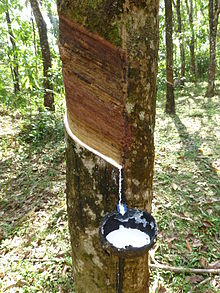As native forests are pushed out to make room for monoculture (single species) plantations, a number of negative consequences are emerging in the the physical environment in Xishuangbanna. These processes have never occurred before on such a large scale, and as a result, there is some discrepancy what concrete environmental effects this process is having. Some of the consequences being suggested by the scientific community can be found below:
- Loss of biodiversity: Over 600 plant species alone have been lost in the region (Hongmao et al., 2002), and a number of animals are disappearing as well. Although nature reserves exist in the region, there is often no connection between them, and large mammals like tigers and elephants have no way to migrate between these locations (Li et al., 2007).

Rubber tapping. Retrieved from Wiki commons. - Edge effects: When forests are cut down, the outer edges of delicate tropical forests are exposed to harsh winds, soil erosion and exotic invaders. Edge effects have not been documented well in Xishuangbanna but are most likely affecting remaining forests.
- Compromised biochemical soil quality: Li et al. (2007) completed a study researching soil change after tropical forests had been replaced with rubber plantations. They found that soil pH were significantly higher in rubber plantations (or more basic), and that soil moisture was also higher (Li et al., 2007, p. 844). This increase in moisture can result in a decrease in water surface runoff, soil erosion, and overall land degradation.
- Nutrient-poor soils: Rubber plantations also typically have less litter because they lack understory vegetation, with broad leaves that prevent other plants from accessing sunlight, and therefore from sharing soil. This causes a cycle of feedback that continues to return less nutrients to the soil (Li et al., 2012). Once nutrients have been stripped from soils, it is very difficult to return their integrity.
- Changes in climate: It has been recorded that there are 100 fewer foggy days per year in Xishuangbanna, a trademark of the tropical forest climate (Li et al., 2007).
It has yet to be seen how this dramatic loss of native forests will affect both communities in Xishuangbanna, as well as for the rest of the world. Native forest cover has a number of benefits, including preventing carbon dioxide from being admitted into the atmosphere, improving water quality, and harboring biodiversity
